The World Health Organization (WHO), along with the World Meteorological Organization, has issued a critical report emphasizing that rising temperatures due to climate change pose significant risks to workers globally, particularly in sectors like construction and agriculture.
The report indicates that millions of employees are at risk of heat stress, impairing their health and productivity. It calls for urgent action from governments, employers, and unions to establish effective adaptation strategies to mitigate these risks. This marks the WHO's first report on workplace heat stress since 1969.
"We need to treat this not just as discomfort but as a serious health threat," stated Rüdiger Krech, WHO's director of environment, climate, and health. He warned that prolonged exposure to elevated body temperatures—over 38 degrees Celsius (100.4 degrees Fahrenheit)—can lead to severe health complications, including strokes, kidney failure, and dehydration.
The urgency of the issue is underscored by the World Meteorological Organization's recent finding that the last decade has recorded the highest temperatures in history, with projections indicating 2024 could be the hottest year yet. Europe has recently experienced temperature spikes exceeding 40 degrees Celsius (104 degrees Fahrenheit), while regions in Africa and the Middle East see temperatures hitting 50 degrees Celsius (122 degrees Fahrenheit). Meanwhile, summer temperatures in the Mediterranean have reached unprecedented averages of 26.68 degrees Celsius (80 degrees Fahrenheit).
The implications of extreme heat extend beyond health, affecting workplace productivity. The report reveals a significant correlation: for each degree rise over 20 degrees Celsius, productivity diminishes by 2%. Additionally, workplace accidents have been shown to rise; a recent analysis during a heatwave found that in Switzerland, incidents increased by 7% when temperatures exceeded 30 degrees Celsius.
In response, several European countries are enacting measures to protect workers from extreme heat. Italy has recently implemented an emergency decree to suspend work during the hottest hours of the day, while regions in Switzerland have paused construction activities under extreme heat conditions.
The WHO's findings also touch on the impact of heatwaves on vulnerable population segments, including the elderly and children, highlighting that schools need adaptation measures as well. Germany has historically declared "Hitzefrei," allowing schools to send students home during extreme heat. However, with such temperatures becoming commonplace, schools are hesitant to make this a regular practice.
As schools reopen in Switzerland amid lingering summer heat, teachers are advised to adjust classes for comfort, but this is not a sustainable solution. Educators like Dagmar Rösler advocate for renovating school spaces with improved ventilation and air conditioning systems to create more suitable learning environments.
The report advocates for collaborative adaptation efforts among governments, employers, local councils, and health authorities. Krech even suggested that school uniforms in the UK be reconsidered in light of rising temperatures, prompting an examination of all facets of adaptation strategies.
Adapting schools, workplaces, and healthcare facilities to endure higher temperatures will be costly. Unfortunately, many governments, particularly in Europe, are currently prioritizing defense budgets over climate change adaptations. Krech cautions that neglecting these investments can lead to greater economic losses due to reduced productivity and health complications arising from heat stress.
As this conversation around climate adaptation intensifies, stakeholders must recognize that proactive investments in safety and health protections are essential, not just for workers and students, but for sustained economic stability.



















